
| Самолеты (сортировка по:) | |||||
| Страна | Конструктор | Название | Год | Фото | Текст |
LVG C.II

|
Страна: Германия Год: 1915
|
| LVG - C.I - 1915 - Германия | <– | –> | LVG - C.III - 1915 - Германия |
 |
J.Herris - LVG Aircraft of WWI. Volume 2: Types C.II-C.V /Centennial Perspective/ (35) |
| LVG C.II 533/15 of Kasta 3, Kagohl I. |
 |
J.Herris - LVG Aircraft of WWI. Volume 2: Types C.II-C.V /Centennial Perspective/ (35) |
| LVG C.II 793/15 of an unknown unit. |
 |
J.Herris - LVG Aircraft of WWI. Volume 2: Types C.II-C.V /Centennial Perspective/ (35) |
| LVG C.II 2137/15 Staffel 6 of Kagohl I. |
 |
J.Herris - Development of German Warplanes in WWI /Centennial Perspective/ (1) |
| LVG C.II 2137/15 of Kasta 6 flown by Jureck and Christensen. |
 |
J.Herris - LVG Aircraft of WWI. Volume 2: Types C.II-C.V /Centennial Perspective/ (35) |
| LVG C.II 2160/15 Staffel 4 of Kagohl I. |
 |
J.Herris - LVG Aircraft of WWI. Volume 2: Types C.II-C.V /Centennial Perspective/ (35) |
| LVG C.II 2165/15 of Kasta 38, Kagohl 7, observer Lt. Hans Loewig, was shot down by 75mm AA fire on 19 July 1916 and subsequently evaluated by the French and appeared in I'Aerophile 1-15 November, 1916. |
 |
J.Herris - LVG Aircraft of WWI. Volume 2: Types C.II-C.V /Centennial Perspective/ (35) |
| LVG C.II 2184/15. Note the 'X' and band on the fuselage and black band on the wheel cover. |
 |
J.Herris - LVG Aircraft of WWI. Volume 2: Types C.II-C.V /Centennial Perspective/ (35) |
| LVG C.II 2234/15 with diamond marking. |
 |
J.Herris - LVG Aircraft of WWI. Volume 2: Types C.II-C.V /Centennial Perspective/ (35) |
| LVG C.II red 2 Staffel 16 of Kasta III. |
 |
J.Herris - LVG Aircraft of WWI. Volume 2: Types C.II-C.V /Centennial Perspective/ (35) |
| LVG C.II with 160 hp Mercedes D.III engine marked with tricolor red, white and black German Federation Markings. |
 |
J.Herris - LVG Aircraft of WWI. Volume 2: Types C.II-C.V /Centennial Perspective/ (35) |
| LVG C.II with camouflage, unit unknown. The camouflage stippling was an unknown color, shown here are dark green. |
 |
J.Herris - LVG Aircraft of WWI. Volume 2: Types C.II-C.V /Centennial Perspective/ (35) |
| LVG C.II tactical number 1 with primitive camouflage. |
 |
В.Кондратьев - Самолеты первой мировой войны |
| LVG C-II, 8 эскадрилья, 2 бомбардировочная эскадра ВВС Германии, май 1916г. |
 |
В.Обухович, А.Никифоров - Самолеты Первой Мировой войны |
| LVG C II |
 |
J.Herris - LVG Aircraft of WWI. Volume 2: Types C.II-C.V /Centennial Perspective/ (35) |
| LVG C.II work number 1594 after capture by the British and painted in British markings. |
 |
J.Herris - LVG Aircraft of WWI. Volume 2: Types C.II-C.V /Centennial Perspective/ (35) |
| LVG C.II floatplane in Turkish service. |
 |
J.Herris - LVG Aircraft of WWI. Volume 2: Types C.II-C.V /Centennial Perspective/ (35) |
| In flight images of two LVG C.II; C.342/15 is shown above. (Peter M. Grosz Collection/STDB) |
 |
J.Herris - LVG Aircraft of WWI. Volume 2: Types C.II-C.V /Centennial Perspective/ (35) |
| LVG C.II 494/15 being transported by horses. |
 |
J.Herris - LVG Aircraft of WWI. Volume 2: Types C.II-C.V /Centennial Perspective/ (35) |
| LVG C.II 509/15 in the field while the crew has a conversation. (Greg VanWyngarden) |
 |
J.Herris - LVG Aircraft of WWI. Volume 2: Types C.II-C.V /Centennial Perspective/ (35) |
| LVG C.II C.511/15 of the first C.II production batch photographed upon arrival at Flieger-Abteilung (A) 292b.The LVG C.II used leading edge radiators from the start of production.The C.II had a vertical seam between the plywood structure around the cockpits and the fabric covering the aft fuselage, which distinguishes the C.II from late-production C.I aircraft with leading edge radiators. (Peter M. Grosz Collection/STDB) |
 |
J.Herris - LVG Aircraft of WWI. Volume 1: B-Types & C.I /Centennial Perspective/ (34) |
| The LVG C.II was the most numerous of the early LVG C-types. Here is LVG C.II 533/15 attached to Kagohl I, Kampfstaffel 3. The 'kink' in the upper left wing aileron (and right aileron) is a hallmark of the Franz Schneider designs. This aircraft has a 160 hp Mercedes D.III engine and the original style of gun turret. Its work number, 1241, is visible on both the fin and rudder. (Courtesy Bruno Schmaling) |
 |
J.Herris - LVG Aircraft of WWI. Volume 2: Types C.II-C.V /Centennial Perspective/ (35) |
| Three-quarter rear view of an L.V.G. biplane, type D.9. LVG C.II 529/15 downed by Jean Navarre on 20 October 1915. |
 |
J.Herris - LVG Aircraft of WWI. Volume 2: Types C.II-C.V /Centennial Perspective/ (35) |
| LVG C.II 529/15 downed by Jean Navarre on 20 October 1915. Navarre in front (top) and in cockpit (below). |
 |
J.Herris - LVG Aircraft of WWI. Volume 2: Types C.II-C.V /Centennial Perspective/ (35) |
| LVG C.II 529/15 downed by Jean Navarre on 20 October 1915. As shown in the magazine photo top right, Navarre was flying a Morane-Saulnier N fighter at the time. |
 |
Журнал - Flight за 1915 г. |
| Captor and Captive. - A German L.V.G. biplane forced to descend by the French aviator, Adjudant N., who was flying the little fast single-seater Morane-Saulnier monoplane seen in the photograph beyond the German machine. |
 |
J.Herris - LVG Aircraft of WWI. Volume 2: Types C.II-C.V /Centennial Perspective/ (35) |
| LVG C.II C.530/15 with supporting ground crew. (Reinhard Zankl) |
 |
J.Herris - LVG Aircraft of WWI. Volume 2: Types C.II-C.V /Centennial Perspective/ (35) |
| FFA 62 has modified LVG C.II 687/15 to carry additional forward-firing armament. (Bruno Schmaling) |
 |
J.Herris - LVG Aircraft of WWI. Volume 2: Types C.II-C.V /Centennial Perspective/ (35) |
| LVG C.II 708/15 with the crew's flying gear stowed on the aft fuselage. (Greg VanWyngarden) |
 |
J.Herris - LVG Aircraft of WWI. Volume 2: Types C.II-C.V /Centennial Perspective/ (35) |
| LVG C.II 771/15 in the field. |
 |
J.Herris - LVG Aircraft of WWI. Volume 2: Types C.II-C.V /Centennial Perspective/ (35) |
| LVG C.II 775/15 heads a lineup of LVG C.IIs of an unknown unit. (Reinhard Zankl) |
 |
J.Herris - LVG Aircraft of WWI. Volume 2: Types C.II-C.V /Centennial Perspective/ (35) |
| LVG C.II 793/15 with air crew. (Reinhard Zankl) |
 |
J.Herris - LVG Aircraft of WWI. Volume 2: Types C.II-C.V /Centennial Perspective/ (35) |
| LVG C.II C.797/15 in the snow. The terrain appears to be on the Eastern Front. |
 |
J.Herris - LVG Aircraft of WWI. Volume 2: Types C.II-C.V /Centennial Perspective/ (35) |
| LVG C.II 798/15 with Lt.d.R. Vinzenz Kochel (observer) and Lt.d.R. Werner Riezler (pilot) of Bavarian FFA 5 (or FFA 5b), at Pouillerie Ferme near Houplin. |
 |
J.Herris - LVG Aircraft of WWI. Volume 2: Types C.II-C.V /Centennial Perspective/ (35) |
| LVG C.II C.917/15 powered by a 160 hp Maybach Mb.III engine. The Maybach was installed in a few production C.II aircraft delivered to both the Army and Navy, primarily to gain operational experience with the engine. The cover over the exhaust was to prevent burns. (Peter M. Grosz Collection/STDB) |
 |
J.Herris - Rumpler Aircraft of WWI /Centennial Perspective/ (11) |
| LVG C.II 2135/15 is at left foreground and three late-production Rumpler C.III aircraft rest in the right foreground on 16 April 1917. Interestingly, there are no insignia on the rudders of the C.III aircraft. A Rumpler C.I is in the center background with another LVG C.II at right background. |
 |
J.Herris - LVG Aircraft of WWI. Volume 2: Types C.II-C.V /Centennial Perspective/ (35) |
| Fahnrich Jureck (L) and Lt. Christensen (R) airman pose with LVG C.II 2137/15. The markings indicate the aircraft is attached to Kampfgeschwader I and is aircraft no.6 of Staffel 6 (VI indicates the Staffel). (Bruno Schmaling) |
 |
J.Herris - LVG Aircraft of WWI. Volume 2: Types C.II-C.V /Centennial Perspective/ (35) |
| The shows the same LVG C.II and crew as the machine on top of p. 145 - Fahnrich Jurek and Lt. Christensen in C.II 2137/15, Kampfstaffel 6 of Kagohl 1 (Kampfgeschwader I). (Bruno Schmaling) |
 |
J.Herris - LVG Aircraft of WWI. Volume 2: Types C.II-C.V /Centennial Perspective/ (35) |
| LVG C.II 2160/15 (Wk. Nr. 1468) from Kampfstaffel 4 of Kagohl 1. French aviators are examining the captured aircraft. This machine was brought down by French airmen on 1 June 1916, south of Bernecourt. The crew of Uffz. Arnold Walter (pilot) and Lt. Schultze-Dellwig (observer) were both captured. It was displayed in Toul on 4 June 1916 and tested and evaluated, and appears in the article on the type in "L'Aerophile". |
 |
J.Herris - LVG Aircraft of WWI. Volume 2: Types C.II-C.V /Centennial Perspective/ (35) |
| LVG C.II aircraft with the same tactical markings as above. Is it the same aircraft or a different aircraft? The tri-color flags in the background indicate it has been captured. |
 |
J.Herris - LVG Aircraft of WWI. Volume 2: Types C.II-C.V /Centennial Perspective/ (35) |
| LVG C.II aircraft from the 1-15 November 1916 issue of L'Aerophile. Above shows aircraft no.5 of Kampfstaffel IV. |
 |
J.Herris - LVG Aircraft of WWI. Volume 2: Types C.II-C.V /Centennial Perspective/ (35) |
| Two images of the LVG C.II. |
 |
J.Herris - LVG Aircraft of WWI. Volume 2: Types C.II-C.V /Centennial Perspective/ (35) |
| LVG C.II 2165/15 (Wk.Nr 1473) captured on 19-7-1916 near Cerseuil (south of Braisnes, Aisne) by a section of 75mm AA artillery. French records reveal this was from Kampfstaffel 38 of Kagohl 7. The crew was taken prisoner: the pilot's name is unrecorded but Lt. Hans Loewig was the observer. It had a Mercedes engine and a broken propeller. The plane was adorned with a black 'V' on each upper wing, a 'V' on the fuselage, and a black 'T' on the vertical fin. (L'Aerophile 1-15 Nov. 1916) |
 |
J.Herris - LVG Aircraft of WWI. Volume 2: Types C.II-C.V /Centennial Perspective/ (35) |
| Two more views of LVG C.II 2165/15 (Wk.Nr 1473) captured on 19-7-1916 near Cerseuil (south of Braisnes, Aisne) by a section of 75mm AA artillery. French records reveal this was from Kampfstaffel 38 of Kagohl 7. The crew was taken prisoner: the pilot's name is unrecorded but Lt. Hans Loewig was the observer. It had a Mercedes engine. The plane was adorned with a black 'V' on each upper wing (per the article in L'Aerophile 1-15 Nov. 1916), a 'V' on the fuselage, and a black 'T' on the vertical fin. (Greg VanWyngarden) |
 |
J.Herris - LVG Aircraft of WWI. Volume 2: Types C.II-C.V /Centennial Perspective/ (35) |
| LVG C.II C.2234/15 (Wk Nr. 1543) is seen after it was captured by the British, and the Lewis gun was fitted by the British. It originally had the usual Parabellum. Later it was taken to England and its original German markings were repainted on the fuselage so it could be paraded through the streets of London as part of the Lord Mayor's Show. This photo probably shows it after it was shipped to England and its original German markings were repainted. It was captured on 21 May 1916, just after it had completed a night bombing raid. It was captured near Saint-Andre-au-Bois (Pas-de-Calais). Its engine number was recorded as Mercedes Nr. 2255. (Peter M. Grosz Collection/STDB) |
 |
J.Herris - LVG Aircraft of WWI. Volume 2: Types C.II-C.V /Centennial Perspective/ (35) |
| LVG C.II 2234/15 was captured by the French and examined in detail. At this time it was repainted in Allied markings. These photos show 2234/15 after repainting in false German markings displayed in the Lord Mayor's Show in London. The surrounds of the national insignia are not accurate. (Greg VanWyngarden) |
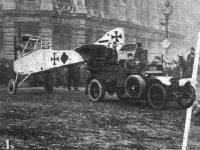 |
Журнал - Flight за 1916 г. |
| Some snaps of the Lord Mayor's Procession: - 1. Fuselage of captured German LVG. |
 |
J.Herris - LVG Aircraft of WWI. Volume 2: Types C.II-C.V /Centennial Perspective/ (35) |
| Another image of LVG C.II 2234/15 being displayed in the Lord Mayor's Show in London. (Greg VanWyngarden) |
 |
J.Herris - LVG Aircraft of WWI. Volume 2: Types C.II-C.V /Centennial Perspective/ (35) |
| LVG C.II 4219/15 with observer demonstrating his gun turret. (Reinhard Zankl) |
 |
J.Herris - LVG Aircraft of WWI. Volume 2: Types C.II-C.V /Centennial Perspective/ (35) |
| "Franz und Emil" stand if front of LVG C.II C.4272/15 (work no.1630) attached to FAA 213. They are well dressed to prevent frostbite. Note the gravity tank on this C.II is offset to port under the upper wing. Because the exhaust header of the Benz engine was on the port side of the engine, the fuel tank had to be placed either on the side opposite to it - the starboard side - in which case it was under the upper wing - or in the middle of the upper wing. The opposite was true of the Mercedes engine - its exhaust header was on the starboard side so the reserve tank was on the port side - or above the wing. The forward bomb chutes have guide rails to prevent the 12.5 kg bombs from hitting the landing gear. (Peter M. Grosz Collection/STDB) |
 |
J.Herris - LVG Aircraft of WWI. Volume 2: Types C.II-C.V /Centennial Perspective/ (35) |
| LVG C.II C.4295/15 with the engine running; the pilot is warming it up perhaps while the observer gets a last second briefing before take-off. (Peter M. Grosz Collection/STDB) |
 |
J.Herris - LVG Aircraft of WWI. Volume 2: Types C.II-C.V /Centennial Perspective/ (35) |
| LVG C.II 430X/15 brings in fresh provisions; pork on the hoof. (Greg VanWyngarden) |
 |
J.Herris - LVG Aircraft of WWI. Volume 2: Types C.II-C.V /Centennial Perspective/ (35) |
| LVG C.II 223/15 (223/16 ???) with crew and bombs to be loaded. (Greg VanWyngarden) |
 |
J.Herris - LVG Aircraft of WWI. Volume 2: Types C.II-C.V /Centennial Perspective/ (35) |
| LVG C.II photographed with a measuring stick for scale. The serial number is partially obscured but appears to be C.290/16. If so that would make it part of the last production batch intended for front-line use. |
 |
J.Herris - LVG Aircraft of WWI. Volume 2: Types C.II-C.V /Centennial Perspective/ (35) |
| LVG C.II 307 with crew and locals. (Reinhard Zankl) |
 |
J.Herris - LVG Aircraft of WWI. Volume 2: Types C.II-C.V /Centennial Perspective/ (35) |
| LVG C.II 309/16 at its airfield. (Greg VanWyngarden) |
 |
J.Herris - LVG Aircraft of WWI. Volume 2: Types C.II-C.V /Centennial Perspective/ (35) |
| LVG C.II 345/16 was from the last production batch intended for combat; subsequent C.II orders, which were built under license by Ago, were intended for advanced training. The engine is a Mercedes. (Peter M. Grosz Collection/STDB) |
 |
J.Herris - LVG Aircraft of WWI. Volume 2: Types C.II-C.V /Centennial Perspective/ (35) |
| LVG C.II 353/16 possibly of FA(A) 223. The crewman is Genth. (Greg VanWyngarden) |
 |
J.Herris - LVG Aircraft of WWI. Volume 2: Types C.II-C.V /Centennial Perspective/ (35) |
| LVG C.II 400/16 of FA(A) 223. (Greg VanWyngarden) |
 |
J.Herris - LVG Aircraft of WWI. Volume 2: Types C.II-C.V /Centennial Perspective/ (35) |
| LVG C.II(Ago) 9941/17 from FEA 8 undergoing heavy maintenance in the shops. Ago-built aircraft were intended for use as trainers. |
 |
J.Herris - LVG Aircraft of WWI. Volume 2: Types C.II-C.V /Centennial Perspective/ (35) |
| LVG C.II of FFA 61. (Bruno Schmaling) |
 |
J.Herris - LVG Aircraft of WWI. Volume 2: Types C.II-C.V /Centennial Perspective/ (35) |
| Fine study of a typical LVG C.II. |
 |
J.Herris - LVG Aircraft of WWI. Volume 2: Types C.II-C.V /Centennial Perspective/ (35) |
| Good photo of a standard LVG C.II, one of the mainstays of the Fliegertruppe from mid 1915 through early 1916. The engine was a Mercedes. (Peter M. Grosz Collection/STDB) |
 |
J.Herris - LVG Aircraft of WWI. Volume 2: Types C.II-C.V /Centennial Perspective/ (35) |
| LVG C.II with tricolor stripes, black-white-red, fore to aft. (Greg VanWyngarden) |
 |
J.Herris - LVG Aircraft of WWI. Volume 2: Types C.II-C.V /Centennial Perspective/ (35) |
| LVG C.II with is crew photographed on 17 April 1916. (Peter M. Grosz Collection/STDB) |
 |
J.Herris - LVG Aircraft of WWI. Volume 2: Types C.II-C.V /Centennial Perspective/ (35) |
| LVG C.II with 150 hp Benz Bz.III with battle damage; note oil leaks. (Greg VanWyngarden) |
 |
J.Herris - LVG Aircraft of WWI. Volume 2: Types C.II-C.V /Centennial Perspective/ (35) |
| Well-maintained LVG C.II at a unit shows moderate use; a Fokker Eindecker is in the background. (Reinhard Zankl) |
 |
J.Herris - LVG Aircraft of WWI. Volume 2: Types C.II-C.V /Centennial Perspective/ (35) |
| Two views of LVG C.II aircraft in the field. |
 |
J.Herris - LVG Aircraft of WWI. Volume 2: Types C.II-C.V /Centennial Perspective/ (35) |
| LVG C.II with Mercedes engine. |
 |
Форум - Breguet's Aircraft Challenge /WWW/ |
 |
J.Herris - LVG Aircraft of WWI. Volume 2: Types C.II-C.V /Centennial Perspective/ (35) |
| LVG C.II no.6 serving with a Kampfgeschwader on the Western Front. (Reinhard Zankl) |
 |
J.Herris - LVG Aircraft of WWI. Volume 2: Types C.II-C.V /Centennial Perspective/ (35) |
| LVG C.II with crew and ground crew in the field. |
 |
J.Herris - LVG Aircraft of WWI. Volume 2: Types C.II-C.V /Centennial Perspective/ (35) |
| LVG C.II gets the once over inspection from visitors. The engine cowling has been removed for maintenance. (Bruno Schmaling) |
 |
O.Thetford, P.Gray - German Aircraft of the First World War /Putnam/ |
| L.V.G. C I (C II ???) |
 |
J.Herris - LVG Aircraft of WWI. Volume 2: Types C.II-C.V /Centennial Perspective/ (35) |
| Pilot with his LVG C.II. (Greg VanWyngarden) |
 |
J.Herris - LVG Aircraft of WWI. Volume 2: Types C.II-C.V /Centennial Perspective/ (35) |
| Mechanics work on an LVG C.II attached to FAA 288 during winter. (Bruno Schmaling) |
 |
J.Herris - LVG Aircraft of WWI. Volume 2: Types C.II-C.V /Centennial Perspective/ (35) |
| LVG C.II with its ground crew in the field with tent hangar in background. (Reinhard Zankl) |
 |
J.Herris - LVG Aircraft of WWI. Volume 2: Types C.II-C.V /Centennial Perspective/ (35) |
| LVG C.II forced down for repair draws onlookers. (Reinhard Zankl) |
 |
J.Herris - LVG Aircraft of WWI. Volume 2: Types C.II-C.V /Centennial Perspective/ (35) |
| LVG C.II and air and crew of FFA 19. (Bruno Schmaling) |
 |
K.Delve - World War One in the Air /Crowood/ |
| A good illustration of the restricted view of pilots in many of these early designs is given by this LVG CII. However, this type was one of the first to be armed with a forward-firing Spandau machine gun and a parabellum gun for the observer. The aircraft entered service late in 1915 for a variety of roles. |
 |
J.Herris - LVG Aircraft of WWI. Volume 2: Types C.II-C.V /Centennial Perspective/ (35) |
| LVG C.II at an unknown unit with unit personnel. The hangars are made of wood, indicating a stable location possibly a training unit. (Peter M. Grosz Collection/STDB) |
 |
J.Herris - LVG Aircraft of WWI. Volume 2: Types C.II-C.V /Centennial Perspective/ (35) |
| LVG C.II captured near Luneville, here at Malmaison. (Greg VanWyngarden) |
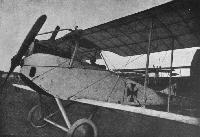 |
Jane's All The World Aircraft 1919 /Jane's/ |
| An L.V.G. C.II biplane, 160 h.p. Mercedes engine of 1916 type. Note the radiator built into the centre sections of the wings. |
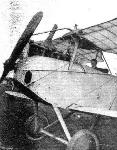 |
Журнал - Flight за 1916 г. |
| CHASSIS AND ENGINE OF AN L.V.G. BIPLANE. - Note how the radiator is built into the top place. |
 |
J.Herris - LVG Aircraft of WWI. Volume 2: Types C.II-C.V /Centennial Perspective/ (35) |
| LVG C.II undergoing maintenance. (Greg VanWyngarden) |
 |
J.Herris - LVG Aircraft of WWI. Volume 2: Types C.II-C.V /Centennial Perspective/ (35) |
| LVG C.II modified with the rear turret replaced by a standard cockpit and the gravity tank removed. (Peter M. Grosz Collection/STDB) |
 |
J.Herris - LVG Aircraft of WWI. Volume 2: Types C.II-C.V /Centennial Perspective/ (35) |
| LVG C.II late-war trainer wears late 1918 insignia. Local people gather to see the aircraft, perhaps flown by the home town pilot trainee at the center of the photo. |
 |
J.Herris - LVG Aircraft of WWI. Volume 2: Types C.II-C.V /Centennial Perspective/ (35) |
| LVG C.II and aircrew. A carbine is attached to the fuselage side and the gravity tank if offset to the left. |
 |
J.Herris - LVG Aircraft of WWI. Volume 2: Types C.II-C.V /Centennial Perspective/ (35) |
| Aircrew with their LVG C.II attached to FAA 6b. (Bruno Schmaling) |
 |
J.Herris - LVG Aircraft of WWI. Volume 2: Types C.II-C.V /Centennial Perspective/ (35) |
| Mechanics work on an LVG C.II attached to FAA 288 during winter. (Bruno Schmaling) |
 |
J.Herris - LVG Aircraft of WWI. Volume 2: Types C.II-C.V /Centennial Perspective/ (35) |
| Detail of the nose and engine of an LVG C.II with 150 hp Benz Bz.III. (Taz Philips) |
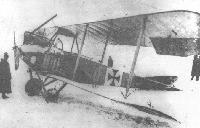 |
В.Кондратьев - Самолеты первой мировой войны |
| LVG C-II, захваченный русской армией в Галиции, зима 1916-1917 годов |
 |
J.Herris - LVG Aircraft of WWI. Volume 2: Types C.II-C.V /Centennial Perspective/ (35) |
| LVG C.II aircraft possibly of Kampfstaffel 17. |
 |
J.Herris - LVG Aircraft of WWI. Volume 2: Types C.II-C.V /Centennial Perspective/ (35) |
| LVG C.II of FFA 11; Josef Jacobs is the pilot - later, of course, the Jasta 22 pilot and Jasta 7 Triplane ace, commander and Pour le Merite winner. The observer is Lt. Walter Schwabedissen; he has a flare pistol and a good flare supply. (Bruno Schmaling) |
 |
J.Herris - LVG Aircraft of WWI. Volume 2: Types C.II-C.V /Centennial Perspective/ (35) |
| An LVG C.II with ground crew loading bombs. (Greg VanWyngarden) |
 |
J.Herris - LVG Aircraft of WWI. Volume 2: Types C.II-C.V /Centennial Perspective/ (35) |
| LVG C.II modified with an additional flexible machine gun. Early production LVG C.II aircraft did not have a fixed gun for the pilot and this field modification helped. A carbine is stored externally. Uffz. Pfannenstiel was the pilot and Lt. Ahlefeld as the observer, from FFA 28. Lt. Ahlefeld mans the wing-mounted Bergmann machine gun - note the special shoulder strap allowing him to stand firm in the cockpit. (Peter M. Grosz Collection/STDB) |
 |
J.Herris - LVG Aircraft of WWI. Volume 2: Types C.II-C.V /Centennial Perspective/ (35) |
| LVG C.II photographed with men of its unit. (Rob Bell) |
 |
J.Herris - LVG Aircraft of WWI. Volume 2: Types C.II-C.V /Centennial Perspective/ (35) |
| LVG C.II had a Benz Bz.III engine and a captured Lewis gun added over the wing. The observer also had an ample supply of flares mounted alongside his cockpit. It almost certainly came from Kampfstaffel 16. The black band on the fuselage and the black nose were the markings of that Staffel. |
 |
J.Herris - LVG Aircraft of WWI. Volume 2: Types C.II-C.V /Centennial Perspective/ (35) |
| LVG C.II in France in May 1916 with possible black-white-red stripe marking. (Greg VanWyngarden) |
 |
J.Herris - LVG Aircraft of WWI. Volume 2: Types C.II-C.V /Centennial Perspective/ (35) |
| Captured LVG C.II here at La Malmaison, made into a period postcard. (Greg VanWyngarden) |
 |
J.Herris - LVG Aircraft of WWI. Volume 2: Types C.II-C.V /Centennial Perspective/ (35) |
| Captured LVG C.II being reviewed by guests at La Malmaison. (Greg VanWyngarden) |
 |
J.Herris - LVG Aircraft of WWI. Volume 2: Types C.II-C.V /Centennial Perspective/ (35) |
| Captured LVG C.II on display was downed near Luneville, and is seen here in June 1916 when it was displayed at La Malmaison. |
 |
J.Herris - LVG Aircraft of WWI. Volume 2: Types C.II-C.V /Centennial Perspective/ (35) |
| LVG C.II with 160 hp Mercedes D.III. The pilot is Josef Muhlfeldt, later of Jasta 23b. (Greg VanWyngarden) |
 |
J.Herris - LVG Aircraft of WWI. Volume 2: Types C.II-C.V /Centennial Perspective/ (35) |
| LVG C.II being prepared for take-off. |
 |
J.Herris - LVG Aircraft of WWI. Volume 2: Types C.II-C.V /Centennial Perspective/ (35) |
| Captured LVG C.II with 160 hp Mercedes D.III at St. Cyr on 9 February 1916. (Greg VanWyngarden) |
 |
J.Herris - LVG Aircraft of WWI. Volume 2: Types C.II-C.V /Centennial Perspective/ (35) |
| LVG C.II tactical number 1 in primitive camouflage. |
 |
J.Herris - LVG Aircraft of WWI. Volume 2: Types C.II-C.V /Centennial Perspective/ (35) |
| LVG C.II with 160 hp Mercedes D.III. Gotthard Sachsenberg, standing in the center, of a Marine Feldflieger-Abteilung. (Greg VanWyngarden) |
 |
J.Herris - LVG Aircraft of WWI. Volume 2: Types C.II-C.V /Centennial Perspective/ (35) |
| Unidentified airman is the observer's cockpit of an LVG C.II attached to FFA 227 with flares and a flare pistol in a rack alongside the observer's cockpit. (Peter M. Grosz Collection/STDB) |
 |
J.Herris - LVG Aircraft of WWI. Volume 2: Types C.II-C.V /Centennial Perspective/ (35) |
| Unidentified personnel pose with an LVG C.II in the field. (Peter M. Grosz Collection/STDB) |
 |
J.Herris - LVG Aircraft of WWI. Volume 2: Types C.II-C.V /Centennial Perspective/ (35) |
| Late-production LVG C.II with a fixed gun for the pilot; early-production C.II aircraft only had a flexible gun for the observer. The observer's gun is wooden, indicating this is a propaganda photo. (Peter M. Grosz Collection/STDB) |
 |
J.Herris - Development of German Warplanes in WWI /Centennial Perspective/ (1) |
| The LVG C.II was a robust early C-type met frequently in combat. Engine was either a 150 hp Benz Bz.III or 160 hp Mercedes D.III. |
 |
J.Herris - LVG Aircraft of WWI. Volume 2: Types C.II-C.V /Centennial Perspective/ (35) |
| The wooden hangars in the background indicated this LVG C.II may be a trainer or at a more stable part of the front. |
 |
J.Herris - LVG Aircraft of WWI. Volume 3: Types C.VI-C.XI & Fighters /Centennial Perspective/ (36) |
| LVG C.II in the field. (Greg VanWyngarden) |
 |
J.Herris - LVG Aircraft of WWI. Volume 2: Types C.II-C.V /Centennial Perspective/ (35) |
| A formation of LVG C.II aircraft of FFA 5b depart on a mission. (Bruno Schmaling) |
 |
J.Herris - LVG Aircraft of WWI. Volume 2: Types C.II-C.V /Centennial Perspective/ (35) |
| View of LVG C.II aircraft in flight. Being used for reconnaissance and training, the C.II was photographed fairly often by companion aircraft in flight. |
 |
J.Herris - LVG Aircraft of WWI. Volume 2: Types C.II-C.V /Centennial Perspective/ (35) |
| In flight view of an LVG C.II. (Reinhard Zankl) |
 |
J.Herris - LVG Aircraft of WWI. Volume 2: Types C.II-C.V /Centennial Perspective/ (35) |
 |
J.Herris - LVG Aircraft of WWI. Volume 2: Types C.II-C.V /Centennial Perspective/ (35) |
 |
J.Herris - LVG Aircraft of WWI. Volume 2: Types C.II-C.V /Centennial Perspective/ (35) |
| LVG C.II in flight. LVG, Albatros, and Aviatik 2-seaters formed the backbone of the early reconnaissance units. |
 |
J.Herris - LVG Aircraft of WWI. Volume 2: Types C.II-C.V /Centennial Perspective/ (35) |
 |
J.Herris - LVG Aircraft of WWI. Volume 2: Types C.II-C.V /Centennial Perspective/ (35) |
| LVG C.II of Kampfstaffel 17, Kagohl 3 in flight. (Greg VanWyngarden) |
 |
J.Herris - LVG Aircraft of WWI. Volume 2: Types C.II-C.V /Centennial Perspective/ (35) |
| LVG C.II landing after a mission. The "V3" markings would indicate a machine of Kampfstaffel X/(5) of Kagohl I. (Bruno Schmaling) |
 |
J.Herris, J.Scott - Fokker Aircraft of WWI. Vol.2: Eindeckers /Centennial Perspective/ (52) |
| A Fokker E.I sits in a hangar among several LVG Zweisitzer. (Peter M. Grosz collection/STDB) |
 |
J.Herris - LVG Aircraft of WWI. Volume 2: Types C.II-C.V /Centennial Perspective/ (35) |
| LVG C.II at Fl. Abt. 21. |
 |
J.Herris - LVG Aircraft of WWI. Volume 2: Types C.II-C.V /Centennial Perspective/ (35) |
| Kagohl I lineup of mostly LVG C.II aircraft. (Bruno Schmaling) |
 |
J.Herris - LVG Aircraft of WWI. Volume 2: Types C.II-C.V /Centennial Perspective/ (35) |
| LVG C.II lineup of Kagohl I. (Bruno Schmaling) |
 |
J.Herris - LVG Aircraft of WWI. Volume 2: Types C.II-C.V /Centennial Perspective/ (35) |
| LVG C.II aircraft of FA 1 at Knust Field. (Bruno Schmaling) |
 |
J.Herris - LVG Aircraft of WWI. Volume 2: Types C.II-C.V /Centennial Perspective/ (35) |
| LVG C.II aircraft of an unidentified Abteilung. |
 |
J.Herris - LVG Aircraft of WWI. Volume 2: Types C.II-C.V /Centennial Perspective/ (35) |
| BAO returned to the Western Front in mid-1915 and was equipped with armed aircraft of the C category. Some of its LVG C II machines, in a variety of finishes, are seen here on Ghistelles aerodrome in December. Shortly afterwards BAO's designation was changed to Kampfgeschwader der Obersten Heeresleitung (Kagohl) (Fighting Squadron of the Army High Command) I and its aircraft were reorganized into six Kampfstaffeln (Fighting sections) - Kasta 1 to 6 - each having a strength of seven aeroplanes. At the same time BAM became Kagohl II with Kasta 7 to 12. Both formations were to have been used in the offensive against Verdun, in concentrated bombing attacks on targets behind the French lines, but this plan suffered attrition because the aircraft were used instead on fighting patrol work. |
 |
A.Imrie - German Bombers /Arms & Armour/ |
| On 20, 21 and 22 May 1916 Kagohl I and III mounted concentrated attacks against Dunkirk. Shown are Kampfstaffeln of Kagohl I, equipped in the main with LVG C II two-seaters (Rumpler C I machines of Kasta II in the foreground) and assembled in take-off order on Ghistelles aerodrome, near Ostend, on 21 May. A strict count-down procedure was maintained; all engines of a Kampfstaffel were started at the same time and machines were broght into line at the edge of the manoeuvring area before the previous unit had taken off. As soon as the last aircraft was airborne, the leader of the following Kasta started his take-off run, the other six machines following within a few seconds of each other. It was thus possible to get the whole Kagohl away in landing was achieved with similar despatch, and surprisingly few accidents accompanied these high-density movements. |
 |
A.Imrie - German Bombers /Arms & Armour/ |
| This aerial view of the same scene shows the specially prepared take-off area, to combat the Flanders mud, that allowed the heavily laden machines of each Kasta to depart in rapid succession. Once airborne, individual aircraft formed up easily on their leader's machine, which flew at reduced speed in a specified direction. Units then adopted their prearranged position in the 40-aircraft-strong formation, and climbed to operating height (generally above 10,000ft) before setting course for the target. |
 |
J.Herris, J.Scott - Fokker Aircraft of WWI. Vol.2: Eindeckers /Centennial Perspective/ (52) |
| The Zeppelin hall at Metz is seen housing a number of Albatros and LVG C-types as well as three Fokker Eindeckers, all of which appear to have been marked with wide white fuselage bands. It is possible that 89/15 and 90/15 are present here. (Peter M. Grosz collection/STDB) |
 |
J.Herris - LVG Aircraft of WWI. Volume 2: Types C.II-C.V /Centennial Perspective/ (35) |
| LVG C.II C.431/15 C.775/15, and 390/15 are on the left in the photo of this repair facility. (Peter M. Grosz Collection/STDB) |
 |
J.Herris - LVG Aircraft of WWI. Volume 2: Types C.II-C.V /Centennial Perspective/ (35) |
| LVG C.II C.407/15 and 593/15 are visible in this photo of LVG-equipped Fl. Abt. 14 on the Eastern Front ready to load on railroad cars for transportation to the Western Front. (Peter M. Grosz Collection/STDB) |
 |
J.Herris - Albatros Aircraft of WWI. Volume 1: Early Two-Seaters /Centennial Perspective/ (24) |
| FliegerAbteilung (A) 230 arrives on the cold, snowy Eastern Front by train, the most reliable way to deliver these early aircraft. An Albatros C.III is visible at right and an LVG C.II is in the middle. |
 |
J.Herris - Nachtflugzeug! German N-types of WWI /Centennial Perspective/ (3) |
| This photo of an LVG C.II probably shows the long-span (13.80 m) Nachtflachen (night wings) version, also known, perhaps unofficially, as the LVG C.IIN and LVG N.I. Unlike the standard C.II that carried four 12.5 kg PuW bombs, this aircraft is carrying six 50 kg PuW bombs under the wings and four 12.5 kg PuW bombs under the fuselage, a far greater bomb load. Interestingly, Idflieg's N-type specification required a bomb load of six 50 kg PuW bombs. Was Idflieg's bomb load requirement based on the long-span LVG's bomb-carrying capability as exemplified in this photo? This aircraft is fitted with a Monson propeller manufactured by the Karl Mohns & Emil Sohn Luftschraubenfabrik in Berlin. The early introduction of the LVG C.II makes it likely the LVG N.I was the first production N-type, although it was almost certainly included in the LVG C.II type inventory in the Frontbestand tables. |
 |
J.Herris - LVG Aircraft of WWI. Volume 2: Types C.II-C.V /Centennial Perspective/ (35) |
| Another photo of an LVG C.II probably showing the long-span (13.80 m) Nachtflachen (night wings) version, the LVG C.IIN/LVG N.I. This aircraft is carrying six 50 kg PuW bombs under the wings but no 12.5 kg PuW bombs under the fuselage. This aircraft is also fitted with a Monson propeller manufactured by the Karl Mohns & Emil Sohn Luftschraubenfabrik in Berlin, which may have been the standard propeller for this C.II version. The aircraft has been painted with a dark color that contrasts starkly with the white backgrounds to the national insignia. (Peter M. Grosz Collection/STDB) |
 |
J.Herris - LVG Aircraft of WWI. Volume 2: Types C.II-C.V /Centennial Perspective/ (35) |
| Although no 50 kg PuW bombs can be seen under the wings of LVG C.II 4334/15 due to the viewpoint of the camera, the very dark camouflage is cause to think this aircraft is probably an LVG C.IIN/LVG N.I. (Peter M. Grosz Collection/STDB) |
 |
J.Herris - LVG Aircraft of WWI. Volume 2: Types C.II-C.V /Centennial Perspective/ (35) |
| The LVG C.II floatplanes were built at Koslin, and this photo shows one during flotation tests at Koslin. The aircraft had a 160 hp Mercedes D.III engine; however, instead of a leading edge radiator normally used by C.II aircraft it used the earlier side radiators. Intended for Turkey, this aircraft had the work number K 81, the 'K' indicating it was built at Koslin. (Peter M. Grosz Collection/STDB) |
 |
J.Herris - LVG Aircraft of WWI. Volume 2: Types C.II-C.V /Centennial Perspective/ (35) |
| The struts attaching the floats to the airframe were much less robust than those of competing Friedrichshafen floatplanes, making the LVG C.II floatplanes unsuitable for use in the rough waters of the North Sea or Baltic. The Turkish insignia on the rudder shows this aircraft was intended for Turkey. The LVG company designation for these aircraft was D 9w, with the 'w' standing for 'Wasser' (water). (Peter M. Grosz Collection/STDB) |
 |
J.Herris - LVG Aircraft of WWI. Volume 2: Types C.II-C.V /Centennial Perspective/ (35) |
| LVG C.II with 160 hp Mercedes D.III at St. Cyr on 9 February 1916. It is being viewed by M. Marchis, professor of the science faculty. (Greg VanWyngarden) |
 |
J.Herris - LVG Aircraft of WWI. Volume 2: Types C.II-C.V /Centennial Perspective/ (35) |
| The gun-ring and cockpits of L.V.G. C.II reconnaissance and general purpose biplane of 1916-17 use, captured by the French. 160 h.p. Mercedes D.III engine, allowing 81 miles per hour. |
 |
J.Herris - LVG Aircraft of WWI. Volume 2: Types C.II-C.V /Centennial Perspective/ (35) |
| Captured LVG C.II with 160 hp Mercedes D.III at St. Cyr on 9 February 1916. (Greg VanWyngarden) |
 |
J.Herris - LVG Aircraft of WWI. Volume 2: Types C.II-C.V /Centennial Perspective/ (35) |
| Captured LVG C.II with 160 hp Mercedes D.III at St. Cyr on 9 February 1916. (Greg VanWyngarden) |
 |
J.Herris - LVG Aircraft of WWI. Volume 2: Types C.II-C.V /Centennial Perspective/ (35) |
| Captured LVG C.II with 160 hp Mercedes D.III at St. Cyr on 1 April 1916. (Greg VanWyngarden) |
 |
J.Herris - LVG Aircraft of WWI. Volume 2: Types C.II-C.V /Centennial Perspective/ (35) |
| LVG C.II with 160 hp Mercedes D.III at La Malmaison on 1 June 1916 captured near Luneville. (Greg VanWyngarden) |
 |
J.Herris - LVG Aircraft of WWI. Volume 2: Types C.II-C.V /Centennial Perspective/ (35) |
| LVG C.II with 160 hp Mercedes D.III at La Malmaison 1 June 1916 captured near Luneville. (Greg VanWyngarden) |
 |
J.Herris - LVG Aircraft of WWI. Volume 2: Types C.II-C.V /Centennial Perspective/ (35) |
| Additional views of an LVG C.II with 160 hp Mercedes D.III at La Malmaison on 1 June 1916 that was captured near Luneville. The C.II has been repainted in French markings. Left is the engine and propeller. (Greg VanWyngarden) |
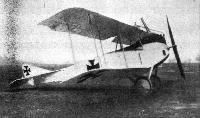 |
Журнал - Flight за 1916 г. |
| Three-quarter front view of a captured L.V.G. biplane. |
 |
J.Herris - LVG Aircraft of WWI. Volume 2: Types C.II-C.V /Centennial Perspective/ (35) |
| LVG C.II captured by the French and repainted in French colors. The comment about "fastest machine in the world" is British propaganda. |
 |
J.Herris - LVG Aircraft of WWI. Volume 2: Types C.II-C.V /Centennial Perspective/ (35) |
| Additional views of an LVG C.II with 160 hp Mercedes D.III at La Malmaison on 1 June 1916 that was captured near Luneville. The C.II has been repainted in French markings. (Greg VanWyngarden) |
 |
J.Herris - LVG Aircraft of WWI. Volume 2: Types C.II-C.V /Centennial Perspective/ (35) |
| LVG C.II apparently captured by the French and repainted in French colors, likely the aircraft above. |
 |
J.Herris - LVG Aircraft of WWI. Volume 2: Types C.II-C.V /Centennial Perspective/ (35) |
| LVG C.II captured by the British; another view of the aircraft on the previous page. |
 |
K.Delve - World War One in the Air /Crowood/ |
| In British markings, this LVG CII was photographed by Capt. D.S. Glover when it was under test with the RFC. The CII had first appeared in late 1915 and by 1916 was in widespread use. |
 |
J.Herris - LVG Aircraft of WWI. Volume 2: Types C.II-C.V /Centennial Perspective/ (35) |
| LVG C.II after it was captured and repainted by the British. |
 |
J.Herris - LVG Aircraft of WWI. Volume 2: Types C.II-C.V /Centennial Perspective/ (35) |
| LVG C.II 2234/15 after it was captured by the British and had all its original markings overpainted, except for the black square visible on the wheel covers. Note that in the top photo it has a Lewis Gun fitted (by the British) but the photo below shows it with its original Parabellum Gun. This is the same machine as seen before, when its original German markings had been repainted for display in London, in the Lord's Mayor's Parade. |
 |
J.Herris - LVG Aircraft of WWI. Volume 2: Types C.II-C.V /Centennial Perspective/ (35) |
| LVG C.II 2234/15 was captured by the French and examined in detail. These are some of the photos of that aircraft after capture. Its engine is a 150 hp Benz Bz.III. (Greg VanWyngarden) |
 |
J.Herris - LVG Aircraft of WWI. Volume 2: Types C.II-C.V /Centennial Perspective/ (35) |
| LVG C.II 2234/15 was captured by the French and examined in detail. These are some of the photos of that aircraft after capture. (Greg VanWyngarden) |
 |
J.Herris - LVG Aircraft of WWI. Volume 2: Types C.II-C.V /Centennial Perspective/ (35) |
| LVG C.II 2234/15 was captured by the French and examined in detail. These are some of the photos of that aircraft after capture. Its engine is a 150 hp Benz Bz.III. (Greg VanWyngarden) |
 |
J.Herris - LVG Aircraft of WWI. Volume 2: Types C.II-C.V /Centennial Perspective/ (35) |
| LVG C.II with Benz Bz.III engine. According to the article, the engine serial number was 2255 and the C.II was 1543. This may have been a work number since it is not compatible with any C.II serial number. (L'Aerophile 1-15 Nov. 1916) |
 |
J.Herris - LVG Aircraft of WWI. Volume 2: Types C.II-C.V /Centennial Perspective/ (35) |
| Detail of the nose and engine of an LVG C.II with 150 hp Benz Bz.III. (Greg VanWyngarden) |
 |
J.Herris - LVG Aircraft of WWI. Volume 2: Types C.II-C.V /Centennial Perspective/ (35) |
| LVG C.II with Mercedes D.III engine. (L'Aerophile 1-15 Nov. 1916) |
 |
J.Herris - LVG Aircraft of WWI. Volume 2: Types C.II-C.V /Centennial Perspective/ (35) |
| LVG C.II after it was captured and repainted for the IRAS on the Eastern Front. |
 |
H.Nowarra, G.Duval - Russian Civil and Military Aircraft 1884-1969 |
| Russian L.V.G. C-II |
 |
А.Александров, Г.Петров - Крылатые пленники России |
| (КПР 40) |
 |
J.Herris - LVG Aircraft of WWI. Volume 2: Types C.II-C.V /Centennial Perspective/ (35) |
| Cockpit of the captured LVG C.II photographed at St. Cyr on 9 February 1916. (Greg VanWyngarden) |
 |
J.Herris - LVG Aircraft of WWI. Volume 2: Types C.II-C.V /Centennial Perspective/ (35) |
| Pilot's cockpit of the LVG C.II. The pilot sat on top of the fuel tank. (L'Aerophile 1-15 Nov. 1916) |
 |
J.Herris - LVG Aircraft of WWI. Volume 2: Types C.II-C.V /Centennial Perspective/ (35) |
| LVG C.II 493/15 after a crash. It was in training service in 1917. (Greg VanWyngarden) |
 |
J.Herris - LVG Aircraft of WWI. Volume 2: Types C.II-C.V /Centennial Perspective/ (35) |
| LVG C.II 519/15 (perhaps work number 1227) after a seriously bad landing. (Greg VanWyngarden) |
 |
J.Herris - LVG Aircraft of WWI. Volume 2: Types C.II-C.V /Centennial Perspective/ (35) |
| LVG C.II C.699/15 of the second C.II production batch suffered from running into a ditch on this landing roll. (Peter M. Grosz Collection/STDB) |
 |
J.Herris - LVG Aircraft of WWI. Volume 2: Types C.II-C.V /Centennial Perspective/ (35) |
| C.II 2109/15 performing a pilot's head stand. |
 |
J.Herris - LVG Aircraft of WWI. Volume 2: Types C.II-C.V /Centennial Perspective/ (35) |
| LVG C.II 2173/15 after a crash. It may have been assigned to Flieger-Beobachter-Schule in Stolp. (Greg VanWyngarden) |
 |
J.Herris - LVG Aircraft of WWI. Volume 2: Types C.II-C.V /Centennial Perspective/ (35) |
| LVG C.II 2228/15 crash. It has a patched bullet hole in the rudder. (Greg VanWyngarden) |
 |
J.Herris - LVG Aircraft of WWI. Volume 2: Types C.II-C.V /Centennial Perspective/ (35) |
| LVG C.II 2228/15 after crashing into a building. |
 |
J.Herris - LVG Aircraft of WWI. Volume 2: Types C.II-C.V /Centennial Perspective/ (35) |
| LVG C.II 4220/15 (work number 1578) destroyed in a crash; tactical number '7' is applied. (Greg VanWyngarden) |
 |
J.Herris - LVG Aircraft of WWI. Volume 2: Types C.II-C.V /Centennial Perspective/ (35) |
| The pilot of LVG C.II 4270/15 wrecked the aircraft in a bad landing. |
 |
J.Herris - LVG Aircraft of WWI. Volume 2: Types C.II-C.V /Centennial Perspective/ (35) |
| LVG C.II 333/16 after a poor landing. (Greg VanWyngarden) |
 |
J.Herris - LVG Aircraft of WWI. Volume 2: Types C.II-C.V /Centennial Perspective/ (35) |
| The crash of LVG C.II 401/16. The holes underneath the fuselage are the after bomb chutes. |
 |
J.Herris - LVG Aircraft of WWI. Volume 2: Types C.II-C.V /Centennial Perspective/ (35) |
| LVG C.II 420/16 wrecked after a bad landing. |
 |
J.Herris - LVG Aircraft of WWI. Volume 2: Types C.II-C.V /Centennial Perspective/ (35) |
| LVG C.II 530/16 after the accident. |
 |
J.Herris - LVG Aircraft of WWI. Volume 2: Types C.II-C.V /Centennial Perspective/ (35) |
| LVG C.II(Ago) 5157/18 trainer destroyed in a crash. All Ago-built LVG C.II were built as advanced trainers. This aircraft was from the last of three batches ordered from Ago. (Peter M. Grosz Collection/STDB) |
 |
J.Herris - LVG Aircraft of WWI. Volume 2: Types C.II-C.V /Centennial Perspective/ (35) |
| LVG C.II with 150 hp Benz Bz.III of Kampfstaffel 17 forced down. (Greg VanWyngarden) |
 |
J.Herris - LVG Aircraft of WWI. Volume 2: Types C.II-C.V /Centennial Perspective/ (35) |
| Airframe of a damaged LVG C.II with bold stripe markings on its fuselage. (Greg VanWyngarden) |
 |
J.Herris - LVG Aircraft of WWI. Volume 2: Types C.II-C.V /Centennial Perspective/ (35) |
| LVG C.II with interesting finish badly damaged after a forced landing. |
 |
J.Herris - LVG Aircraft of WWI. Volume 2: Types C.II-C.V /Centennial Perspective/ (35) |
| Crashed LVG C.II with markings similar to those on LVG C.II 2234/15. (Greg VanWyngarden) |
 |
J.Herris - LVG Aircraft of WWI. Volume 2: Types C.II-C.V /Centennial Perspective/ (35) |
| Crashed LVG C.II, possibly of Kampfstaffel 19. (Greg VanWyngarden) |
 |
J.Herris - LVG Aircraft of WWI. Volume 2: Types C.II-C.V /Centennial Perspective/ (35) |
| Crashed LVG C.II attached to FAA 4b. (Bruno Schmaling) |
 |
J.Herris - LVG Aircraft of WWI. Volume 2: Types C.II-C.V /Centennial Perspective/ (35) |
| LVG C.II has crashed severely. (Greg VanWyngarden) |
 |
J.Herris - LVG Aircraft of WWI. Volume 2: Types C.II-C.V /Centennial Perspective/ (35) |
| Crashed LVG C.II. (Greg VanWyngarden) |
 |
J.Herris - LVG Aircraft of WWI. Volume 2: Types C.II-C.V /Centennial Perspective/ (35) |
 |
Журнал - Flight за 1917 г. |
 |
Журнал - Flight за 1917 г. |
 |
Журнал - Flight за 1917 г. |
 |
Журнал - Flight за 1917 г. |
 |
Журнал - Flight за 1917 г. |
 |
Журнал - Flight за 1917 г. |
 |
J.Herris - LVG Aircraft of WWI. Volume 2: Types C.II-C.V /Centennial Perspective/ (35) |
| The LVG C.II had the aileron 'kink' typical of early LVG designs. (L'Aerophile 1-15 Nov. 1916) |
 |
Журнал - Flight за 1916 г. |
| Diagrammatic sketch of the peculiar stepped ailerons of the L.V.G. biplanes. |
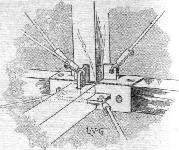 |
Журнал - Flight за 1916 г. |
| Sketch showing attachment of struts to body rails in the L.V.G. biplanes. |
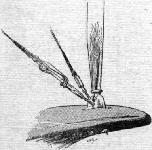 |
Журнал - Flight за 1916 г. |
| Inter plane strut socket and quick-release device on the L.V.G. biplane. |
 |
Журнал - Flight за 1916 г. |
| The quick release device employed in the wing bracing of an L.V.G. biplane. |
 |
J.Herris - LVG Aircraft of WWI. Volume 2: Types C.II-C.V /Centennial Perspective/ (35) |
| LVG C.II pilot's control details. (L'Aerophile 1-15 Nov. 1916) |
 |
J.Herris - LVG Aircraft of WWI. Volume 2: Types C.II-C.V /Centennial Perspective/ (35) |
| LVG C.II observer's gun mount details. (L'Aerophile 1-15 Nov. 1916) |
 |
J.Herris - LVG Aircraft of WWI. Volume 2: Types C.II-C.V /Centennial Perspective/ (35) |
| The French captured some LVG C.II aircraft and documented the type's features in the 1-15 November 1916 issue of L'Aerophile; these drawings are from that article. (L'Aerophile 1-15 Nov. 1916) |
 |
J.Herris - LVG Aircraft of WWI. Volume 2: Types C.II-C.V /Centennial Perspective/ (35) |
 |
O.Thetford, P.Gray - German Aircraft of the First World War /Putnam/ |
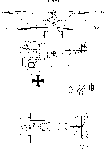 |
В.Кондратьев - Самолеты первой мировой войны |
| LVG C-II |
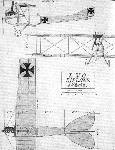 |
Журнал - Flight за 1916 г. |
 |
J.Herris - LVG Aircraft of WWI. Volume 3: Types C.VI-C.XI & Fighters /Centennial Perspective/ (36) |
| LVG C.II |
 |
J.Herris - LVG Aircraft of WWI. Volume 3: Types C.VI-C.XI & Fighters /Centennial Perspective/ (36) |
| LVG C.II |
 |
J.Herris - LVG Aircraft of WWI. Volume 3: Types C.VI-C.XI & Fighters /Centennial Perspective/ (36) |
| LVG C.II Short-Span Wings |
 |
J.Herris - LVG Aircraft of WWI. Volume 3: Types C.VI-C.XI & Fighters /Centennial Perspective/ (36) |
| LVG C.II |
 |
J.Herris - LVG Aircraft of WWI. Volume 3: Types C.VI-C.XI & Fighters /Centennial Perspective/ (36) |
| LVG C.IIN |